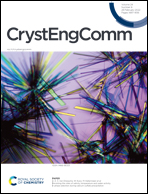Three-fold interpenetrated metal–organic framework as a multifunctional fluorescent probe for detecting 2,4,6-trinitrophenol, levofloxacin, and l-cystine†
Abstract
Multifunctional metal–organic frameworks (MOFs) as fluorescent probes have been proven to be practical tools for future sensing devices. We herein report a new luminescent MOF, {[Zn3(TLA)2(H2O)2(4-abpt)2]·5CH3OH}n (1) (trimellitic acid = H3TLA, 4-amino-3,5-bis(4-pyridyl)-1,2,4-triazole = 4-abpt), which was synthesized under solvothermal conditions and then characterized. 1 has a three-dimensional polymeric coordination structure with a V-shaped trinuclear metal–oxygen [Zn3] unit. The adjacent [Zn3] units are further connected by TLA3− and 4-abpt linkers, resulting in the generation of a 3D coordination polymeric network with obvious 3D channels. Moreover, 1 demonstrates a unique three-fold interpenetrated network and exhibits excellent chemical and thermal stabilities. Interestingly, 1 can be used as a sensitive and recyclable fluorescent probe for the detection of 2,4,6-trinitrophenol (TNP), levofloxacin (LVX), and L-cystine (L-Cys) with low limits of detection (LOD) of 5.24, 7.47 and 5.05 μM, respectively.



 Please wait while we load your content...
Please wait while we load your content...